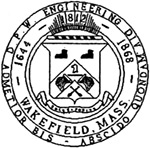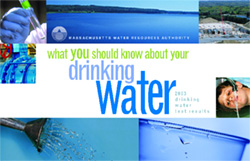Massachusetts Water Resources Authority
2003 Report on your Drinking Water - a message from your local water department
TOWN OF WAKEFIELD
Department of Public WorksPublic Water Supply # 3305000
Wakefield’s Water Supply
The Town of Wakefield uses an average of 2.7 million gallons of water a day. About 85% of this water is supplied by the MWRA through two connections. The remaining 15% is supplied by Wakefield from the Broadway Treatment and Pumping Facility utilizing the high quality source water of Crystal Lake. DEP limits the amount of water the Town can take from Crystal Lake to a maximum of 580,000 gallons per day. Therefore, we use the Broadway Facility to supplement the MWRA supply and to aid in times of high demand, such as in the summer or fire fighting situations. The Broadway Facility can also supply 100% of the Town’s water in the event of an emergency, such as interruptions in the MWRA supply. This dependability makes the Broadway Facility an invaluable part of Wakefield’s water system.
Water Department Staff and Operations
The Wakefield Water Department maintains and operates the Broadway Treatment Facility and the Crystal Lake Watershed. We also operate and maintain approximately 100 miles of water main, 950 fire hydrants, the Linden Street water booster station, the Harts Hill standpipe, pressure reducing valves, blow-off valves, and multiple gate and service valves. We maintain the system including leak detection, repairs to main breaks, water main replacement, replacing older water meters, water main flushing, replacing hydrants, as well as responding to the needs and concerns of the residents. The Department maintains approximately 8,000 water meters and reads each one quarterly (32,000 readings per year). We conduct a thorough water sampling and testing program meeting all State and Federal requirements. We also maintain an active Cross Connection Control Program, continuously inspecting facilities and testing devices to protect the water system from contamination.New Broadway Water Treatment Plant Completed
We completed construction of the new Broadway Water Treatment Plant in April 2003. The facility houses state-of-the-art chemical feed systems, pumps, and a water quality laboratory in a structure consistent with the architecture of the original Broadway facility. It has a disinfection process compatible with the MWRA supply, more efficient pumps, and corrosion control treatment to reduce the potential for lead and copper in the water.
Lead Analysis and Results
The new Broadway Water Treatment Plant at Crystal Lake includes corrosion control treatment that has been on line since April 2003. After the water is filtered, the pH is increased to make it less corrosive and reduces the water’s potential to leach lead from pipes and other fixtures.To monitor the progress of the new treatment, the Water Department collected samples from sixty homes in June and December 2003. The results showed that the Town’s water met and exceeded the EPA standard for lead. These test results show that that the new treatment is working as planned and has resulted in substantial reductions in lead levels in our community.
Water Analysis
The Town of Wakefield and the MWRA analyze water samples regularly to ensure we meet all standards. In 2003, we tested for more than 100 substances. We only detected 7 regulated contaminants and found all of these to be below all federal and state standards. Table 1 also shows the amount (detected level) of each contaminant. Not listed are the more than 100 regulated substances that we did not detect in our water last year.
Units MCL (Highest Level Allowed) Highest Level Found
MCLG
(Ideal Goals)Violation How it Gets In the Water Turbidity (1) NTU TT=5 NTU 0.21 No Standard No Soil runoff TT=% of samples < 1.0 NTU 100% Fluoride
ppm
4
0.94
4
No
Water additive which promotes strong teeth
Nitrate ppm 10 0.5 10 No Runoff from fertilizer use, leaching from sceptic tanks, sewage, erosion of natural deposits Total
Trihalomethanesppb
80 (2)
61 (3)
0 No Byproducts of drinking water disinfection Range of detection 48-82 (4) Haloacetic Acids ppb 60 (2) 35 (3) 0 No Byproducts of drinking water disinfection Range of detection 27-50 (4) Uranium
ppb 30
0.3 No Erosion of natural deposits Lead ppb AL = 15 (5)
7 (5) 0 No Corrosion of household plumbing systems Range of detection 1-35 (5) Only 1 of the 60 sites tested were above the action level NOTES
(1) TT = Treatment Technique: Turbidity is a measure of treatment performance and is regulated as a treatment technique. In Wakefield, 100% of samples met the treatment technique requirement.
(2) Highest level allowed (MCL) for this substance is based on the average of four quarterly samples.
(3) Highest detected level is based on average of four quarterly samples as required by regulation.
(4) Highest value in range is based on individual samples, rather than averages.
(5) For lead, the Action Level (AL) and the highest level found are based on the 90th percentile of the samples. Lead results were obtained in June 2003 and December 2003.Definitions are available in the body of the MWRA report.
We encourage you to participate in Town Meeting and meetings of the Board of Selectmen on matters relative to the Town’s water system. If you have any questions or concerns about lead in your drinking water and would like to have it tested, the Town sponsors a testing program with sample bottles available at the Town Hall.
For any additional information please contact:
Steven Fitzpatrick, Water Superintendent
Department of Public Works
William J. Lee Memorial Town Hall
1 Lafayette Street, Wakefield, Massachusetts 01880
Tel. (781) 246-6300
Fax (781) 246-6266

